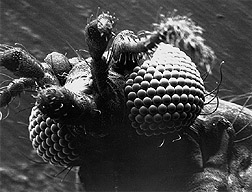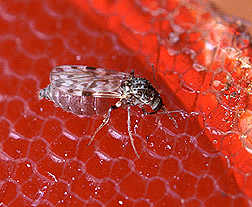The BLUETONGUE Triangle
In the 1800s, U.S. Department of Agriculture scientists discovered that some livestock diseases spread from animal to animal through ticks, flies, midges, or other insects. But in most cases, researchers are still unraveling the complex relationships between the animal hosts, the insect vectors, and the disease agents.
For U.S. livestock producers, virus-caused bluetongue is one of the most important of these vector-borne diseases. Bluetongue viruses can cause serious illness and death in sheep.
A sheep with bluetongue can develop swollen lips and tongue. A lack of oxygen supply to the tongue can cause it to turn bluish or purple, and the animal can have trouble breathing and swallowing. While less than 5 percent of infected U.S. sheep die, bluetongue strains in other countries can cause much higher mortality. There is no cure for the disease.
In the United States, bluetongue has a greater economic impact on the cattle industry--which is much larger than the sheep industry--even though infected cattle don't become noticeably ill. That's because they carry the virus for a few months after infection. The virus can also infect goats and wild ruminants like deer, elk, and pronghorn antelope.
The Office of International Epizootics in Paris, France, classifies bluetongue as "List A," meaning it's a disease that spreads rapidly and crosses international borders. As a result, countries without bluetongue restrict importation of live animals, semen, embryos, and some other animal-based products. This costs U.S. cattle and sheep producers an estimated $125 million annually in lost trade and in testing to certify that the animals or products don't carry any of the bluetongue viruses.
And just as other countries restrict trade with the United States, the USDA's Animal and Plant Health Inspection Service also monitors imported livestock to prevent the entry of foreign bluetongue virus strains.
At the Base of the Triangle
|
|
Scientists at the Agricultural Research Service's Arthropod-Borne Animal Diseases Research Laboratory in Laramie, Wyoming, are the only U.S. team studying all three components of the bluetongue problem: insects, animals, and virus.
The researchers' goal is to provide regulators with a detailed understanding of how bluetongue spreads and whether it can be transmitted from cattle after a finite period of time. In that way, they hope to ease restrictions in some areas of trade, while ensuring that U.S. livestock is also protected from foreign strains of the virus.
Their research has led to some key findings:
- Parts of the United States could eventually be declared bluetongue-free, because the biting midges in the Northeast don't spread the virus.
- Chemicals in the salivary glands of insects may facilitate the spread of viruses to animals.
- Certain genetic sequences in the bluetongue pathogen can speed its detection and reduce the risk that bluetongue will be confused with other diseases.
The researchers at Laramie are also making important discoveries about genes in the midges that allow these tiny creatures to serve as vectors.
Twenty-four different strains of the bluetongue virus have been identified. Scientists at the Laramie laboratory helped determine that five of them exist in the United States.
Female midges, Culicoides variipennis, that feed on the blood of infected animals take up bluetongue viruses as they feed. Then, when the insects feed again, they can inject the viruses into a host animal's blood.
Removing Barriers
Research is slowly paying off in trade benefits.
Studies by many scientists, including some at Laramie, show that the midges are dormant or absent during the winter in cold areas and that bluetongue is not transmitted while adult insects aren't active. As a result, Canada now allows trade from New York and some other northern states during the "insect-free" season.
In Laramie, the scientists at the arthropod lab hope to extend those trade benefits based on new information about the midges. ARS entomologists Edward T. Schmidtmann, Fredrick R. Holbrook (retired), and Walter J. Tabachnick have found both ecological and genetic support for declaring several states free of bluetongue. These are the northernmost states, from North Dakota to Maine, down to West Virginia and over to Delaware.
One Species—or Three?
|
|
More than 110 species of Culicoides midge, also known as biting gnats or no-see-ums, are found in the United States. Researchers have long thought that a complex of three subspecies--C. variipennis variipennis, C. variipennis sonorensis, and C. variipennis occidentalis are involved in the spread of bluetongue.
But research at the Laramie lab indicates that the three are actually separate species: C. variipennis, C. sonorensis, and C. occidentalis. "Several researchers here have shown over the past few years that variipennis doesn't have the ability to spread bluetongue. And we've shown that sonorensis is the primary vector," says Tabachnick. "If we can prove this genetically, regions with only variipennis should be safe from bluetongue."
Sonorensis and occidentalis are found in parts of the South and in western states, while variipennis lives in the Northeast. "In virtually every case where bluetongue has been detected in cattle in the Northeast, the animal came from another part of the country," he says.
Tabachnick's genetic studies indicate that variipennis can't breed with sonorensis or occidentalis. He's also found the first gene that controls the ability of sonorensis to become infected with bluetongue viruses.
There are several likely genes that make sonorensis a good vector. Tabachnick and ARS entomologist Richard A. Nunamaker are constructing maps of the sonorensis genome to find these genes.
Nunamaker and colleagues at the University of Memphis (Tennessee) have also isolated a DNA sequence that controls production of a temperature-induced protein in the midge. This means the scientists are closer to knowing which gene controls cold tolerance in the insects.
"This finding opens the door to using genetic engineering to alter the insect's ability to survive in certain temperate areas that are currently part of its range," Nunamaker says.
Schmidtmann has also found environmental factors that support the existence of three species in the C. variipennis complex. Larvae of all three live in aquatic sediments, but "levels of salt and boron correlate with which species is present," Schmidtmann says.
In Virginia, he found sonorensis only in a highly organic dairy waste pond--and variipennis largely everywhere else. Occidentalis larvae live in highly saline inland lakes in the West, like Borax Lake in California.
"Although we don't have specific, practical management suggestions yet, this work indicates that sonorensis populations could be controlled through environmental management," Schmidtmann says.
Insect Chemicals Aid Virus' Spread
Other researchers at the Laramie lab are unraveling the relationship between the insects and their animal hosts. Tabachnick and colleague Adalberto Perez de Leon, who is now with Rhone-Poulenc at Research Triangle Park, North Carolina, have investigated the effects of insect feeding.
In the midges' salivary glands, "one of the enzymes slows down blood clotting, so the insect can feed easier," Tabachnick says. "This also seems to improve transfer of the virus from the insect to the animal."
Other chemicals in the salivary glands may weaken the host animal's immune system, making it more susceptible to disease. "One insect doesn't have that great an impact. But in nature, thousands of insects may bite an animal every day during the summer," says Tabachnick.
He notes that these findings show the importance of using live animals and insects--the natural virus delivery method--to study vector-borne viruses. Laboratory studies might not reflect the real-world situation.
Tests for Bluetongue and EHD
In yet another approach, ARS microbiologists James O. Mecham and William C. Wilson examine bluetongue virus proteins and genes. Their research has led to improved diagnostic procedures for bluetongue viruses and related viruses that cause epizootic hemorrhagic disease, or EHD.
"EHD causes an often fatal illness in white-tailed deer, and it can give cattle a bluetongue-like disease," says Mecham. "For trade purposes, it is very important to be able to tell the two diseases apart." The midges that transmit bluetongue can also spread EHD.
Research at Laramie and other locations had shown that bluetongue viruses have 10 genetic segments and that differences in one of these segments distinguish each strain. Mecham and Wilson demonstrated a similar genetic makeup for the two U.S. strains of the EHD virus.
Mecham produced monoclonal antibodies that bind to specific proteins in the bluetongue viruses. Then he used the antibodies to develop an antigen capture ELISA test that detects the virus in insects and in the blood of infected animals. A specific series of amino acids produced in the laboratory, a monoclonal antibody recognizes and binds to a specific protein. Researchers use the ELISA test to evaluate the ability of the insect vectors to become infected with the viruses.
Wilson developed separate laboratory assays using polymerase chain reactions, or PCR, that detect the presence of RNA genetic material for each of several bluetongue or EHD viruses. The assays are being combined into a single test to differentiate the viruses. Wilson has also developed the first PCR test that differentiates all five U.S. strains of the bluetongue virus. Specialists at USDA's National Veterinary Services Laboratory in Ames, Iowa, have adapted the test for use in their diagnostic panel for bluetongue.
Mecham has also produced monoclonal antibodies and a competitive ELISA test that distinguishes animals infected with EHD viruses from those infected with bluetongue viruses.
"The international trade of animals and their products will continue to grow in the 21st century," says Tabachnick. ARS research programs like those at the Laramie laboratory seek to find the mechanisms controlling the spread of arthropod-borne animal pathogens like the viruses that cause bluetongue and EHD.
"Understanding factors that govern the role of the insect vector in the disease process, the genetics and evolution of the pathogens, and the effects on the animal host will be the basis for reducing the impact of these pathogens on animal health in the next millennium," he says.— By Kathryn Barry Stelljes, Agricultural Research Service Information Staff.
This research is part of Animal Health and Animal Pests and Parasites, ARS National Programs described on the World Wide Web at http://www.nps.ars.usda.gov/programs/appvs.htm.
James O. Mecham and other scientists mentioned in this story are at the USDA-ARS Arthropod-Borne Animal Diseases Research Laboratory, P.O. Box 3965, University Station, Laramie, WY 82071-3945; phone (307) 766-3600, fax (307) 766-3500.
"The BLUETONGUE Triangle" was published in the July 1999 issue of Agricultural Research magazine.











